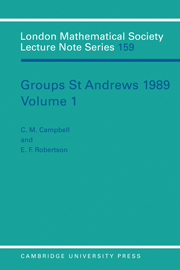Book contents
- Frontmatter
- Contents
- CONTENTS OF VOLUME II
- Preface
- Introduction
- 1 Triply factorized groups
- 2 An introduction to a class of two relator groups
- 3 An infinite family of nonabelian simple table algebras not induced by finite nonabelian simple groups
- 4 Horace Y Mochizuki: In Memoriam
- 5 Bounds on character degrees and class numbers of finite non-abelian simple groups
- 6 Finite presentability and Heisenberg representations
- 7 On nilpotent groups acting on Klein surfaces
- 8 Some algorithms for polycyclic groups
- 9 On the regularity conditions for coloured graphs
- 10 Multiplet classification of highest weight modules over quantum universal enveloping algebras: the Uq(SL(3,C)) example
- 11 Solutions of certain sets of equations over groups
- 12 Generalizing algebraic properties of Fuchsian groups
- 13 A theorem on free products of special abelian groups
- 14 Schur algebras and general linear groups
- 15 On Coxeter's groupsp,q,r
- 16 Integral dimension subgroups
8 - Some algorithms for polycyclic groups
Published online by Cambridge University Press: 05 April 2013
- Frontmatter
- Contents
- CONTENTS OF VOLUME II
- Preface
- Introduction
- 1 Triply factorized groups
- 2 An introduction to a class of two relator groups
- 3 An infinite family of nonabelian simple table algebras not induced by finite nonabelian simple groups
- 4 Horace Y Mochizuki: In Memoriam
- 5 Bounds on character degrees and class numbers of finite non-abelian simple groups
- 6 Finite presentability and Heisenberg representations
- 7 On nilpotent groups acting on Klein surfaces
- 8 Some algorithms for polycyclic groups
- 9 On the regularity conditions for coloured graphs
- 10 Multiplet classification of highest weight modules over quantum universal enveloping algebras: the Uq(SL(3,C)) example
- 11 Solutions of certain sets of equations over groups
- 12 Generalizing algebraic properties of Fuchsian groups
- 13 A theorem on free products of special abelian groups
- 14 Schur algebras and general linear groups
- 15 On Coxeter's groupsp,q,r
- 16 Integral dimension subgroups
Summary
Introduction
The algorithmic theory of some solvable groups appears now to be rather complete. In the near future two rather large papers will appear which will give complete details of the algorithms for polycyclic-by-finite groups devised by me together with Gilbert Baumslag, Derek J S Robinson and Dan Segal [BCRS]. In addition, Dan Segal will give additional algorithms for automorphisms of these groups which will conclude with a positive solution for the isomorphism problem [DS]. Another development that bears watching is the actual implementation of some of these algorithms for high speed computers. Indeed, Charles Sims has almost got the so-called “polycyclic quotient algorithm” devised by Gil Baumslag, myself and Chuck Miller [BCM IV] running; something that very few of us dreamed could happed (see [CS]). So for the first time a practical theory of computing in group theory with some real depth seems likely. No one can tell where this could lead.
The property of polycyclic-by-finite groups that facilitates this development is that they are coherent. That is, they and all their subgroups are finitely presented. Another important feature is that these groups have an easily recognized (finite) presentation. Indeed, if one writes down a so-called polycyclic presentation (see below), which inevitably presents a solvable group, then the polycyclic quotient algorithm referred to above enables you to effectively decide if the group presented is polycyclic [BCM IV].
- Type
- Chapter
- Information
- Groups St Andrews 1989 , pp. 76 - 83Publisher: Cambridge University PressPrint publication year: 1991



